India has always been exalted and remembered fondly as the country of symbolic colors. To an outsider, the colorful culture, streets, and stories seem like a page out of an ancient folk tale. But color, in essence, has been a large part of the Indian consciousness.
Symbolic Colors of India
From the deep orange marigold flowers that bejewel almost every celebration to the deep hues of red that deck up the bride on her most important day, symbolic colors in India have, over time, become synonymous with religion – an expression of faith and beliefs. In a country where a deep understanding of the prevalent diversity is perhaps the only common thread that ties its people together, India is a magical experience that you will not want to miss.
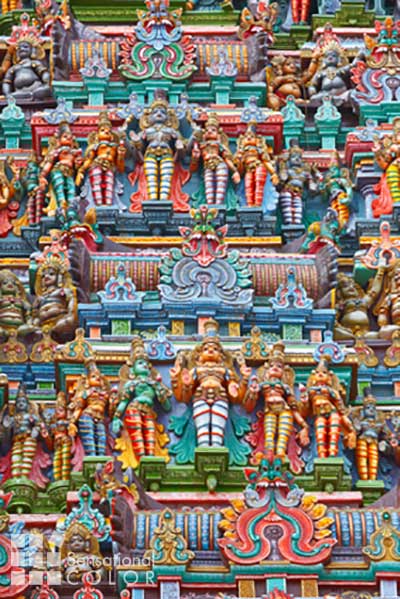
Menakshi Temple, Madurai, Tamil Nadu, India
In a country as diverse and culturally vibrant as India, it is perhaps the common, simple expressions of color that hold together the multitudes of outlooks, lifestyles, and traditions. The symbolism of color stands out and controls every aspect of life in India, be it religion, politics, festivals, or celebrations. In India, be it the north, south, west, or east, color and culture go hand in hand. Just like many other cultures across the world, there are some typical classifications of color to be found in India.
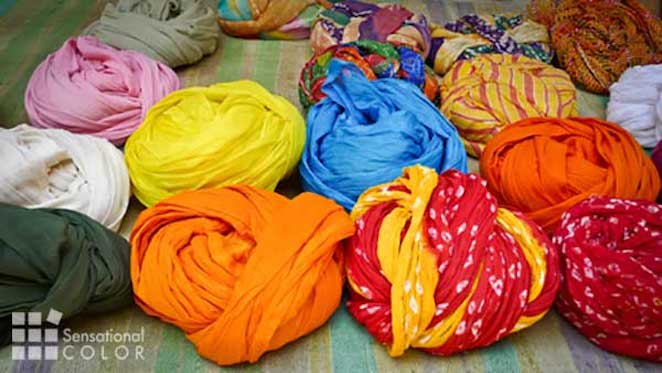
Colorful turbans for sale in Jaisalmer, Rajasthan, India.
Black in India has connotations with lack of desirability, evil, negativity, and inertia. It represents anger and darkness and is associated with the absence of energy, barrenness, and death. Black is used as a representation of evil and is often used to ward off evil. This symbolism is an age-old custom amongst Indians where an infant or, for that matter, anyone looking spectacular is often traditionally blessed with a little black dot on the chin or under the ear to ward off the evil eye. And while white stands for everything desirable in the West, in India it takes on a more somber connotation.
White is the absence of color and is the only color widows are allowed to wear. It is the acceptable color at funerals and ceremonies that mark death in the family. It reflects the essential quality of the color itself, in principle; white, as a color, repels all light and colors and therefore, when a widow wears white, she disconnects herself from the pleasures and luxuries of active and regular participation in society and life around her. White is also widely accepted as the color of peace and purity and is diametrically opposite to red, the color of violence and disruption in the southern half of India.
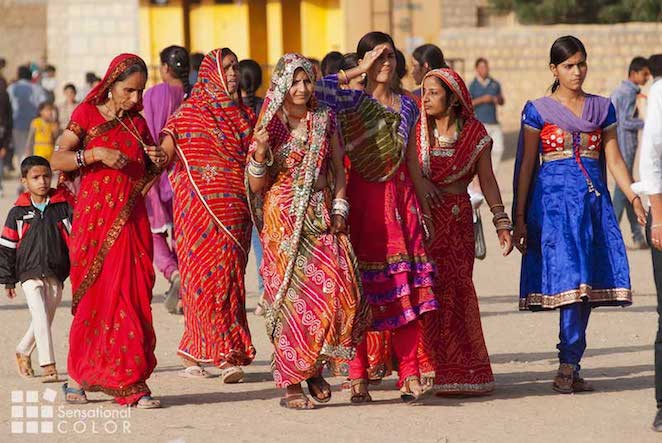
A group of women at the Desert Festival in Jaisalmer, India
Red is dynamic and continuously breathing fire in the eyes of the beholder. It incites fear and is the color associated with one of the most revered goddesses in Hindu mythology – Durga, her fiery image enhanced by her red tongue and almost red eyes. Red also stands for purity and is the preferred color for a bride’s garment. Red has a deep meaning in the Indian psyche.
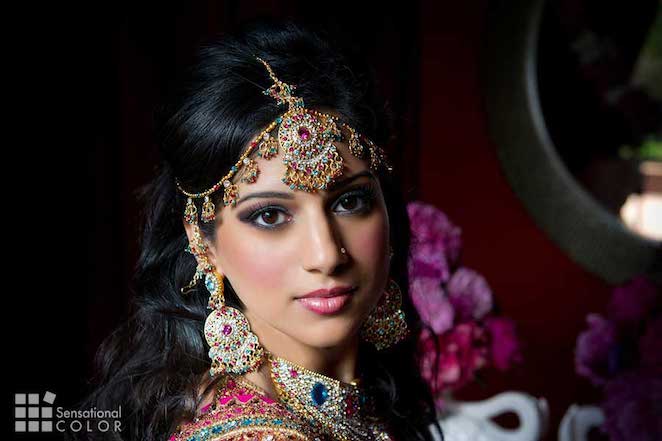
A beautiful Indian bride
It commemorates the union between two people and is visible right from the wedding, where the bride wears brilliant hues of red to the red tikka (spot on forehead) that she adorns after the wedding as a sign of her commitment. It is perhaps easy to see why red also symbolize fertility and prosperity. It is the color of the fertile clay that reaps harvests and better lives and is used widely in prayer ceremonies and offerings. And India could hardly be celebrated as the land of spices without its most feisty ingredient — chilies. And while red symbolizes fertility and purity, it also connotes a certain sensuousness and demands positive energy.
India: Home To Myriad Symbolic Colors
Because of the apparent diversity in its population, India is home to myriad interpretations and representations of symbols and colors. Colors represent different emotions to people living in various regional, geographical, and religious divides. And perhaps specific colors that have a special place in a particular area may not necessarily enjoy a similar status elsewhere. Some of the universally celebrated colors find their origins in the spices that are used widely across geographic and religious divides. Turmeric, for instance, while being used for cooking in both the north and the south, is also used in ceremonies offering prayers and marriages. Yellow symbolizes sanctity and is an essential herbal ingredient applied on the body and face by women in the subcontinent. In a country steeped in religious beliefs, the origin of most colors lies in the powers and mythical lives of its gods.
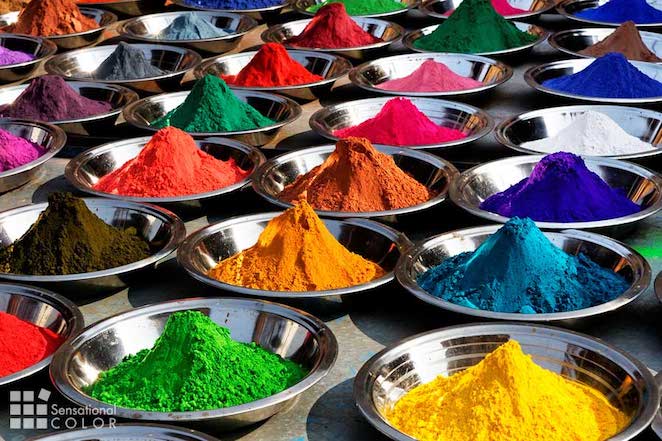
Colorful Tika Powders at the Orcha Market in India
The color blue, for instance, is associated with Lord Krishna, perhaps one of the most favored gods in India. And, as is evident for any agricultural economy, green symbolizes a new beginning, harvest, and happiness. It is also the revered color of Islam, a significant religious presence in India.
Green symbolizes nature and therefore is a manifestation of God himself. India is a country steeped in tradition, culture, and rich and fabulous history. Kings and kingdoms, saints and followers, rebels and fighters have traversed the paths of its glorious past and have all played a small but significant role in ascertaining the perception of colors today.
Some of the glaring differences between the perception of color in the West and the East are due to the simplest elements in history. Royalty, in the West and the Christian culture, is represented by a deep, mystical shade of purple, while in India, it is the deep hues of red and ochre that symbolize wealth and grandeur. Perhaps one of the most poignant factors in the perception of colors in the Indian psyche is the religious undertones that coexist at almost every phase of an “Indian’s life.”
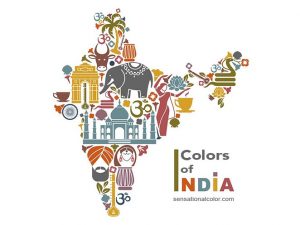
Today, colors are symbols of fear, conformity, and blind faith across the country monopolized by the contorted ways of politics. India remains colorful and vibrant in more ways than one. It stands strong as perhaps the most stoic example of unity in a world so divided. And the colors that hold it together are the colors of faith, pride, and love – feelings that overcome all differences.
The colors of India have mesmerized rulers, outsiders, and visitors – perhaps more so because of the stories and legends that bind its people, its culture, and its beliefs. The “rani” pink of mystical Rajasthan, the pastel tones of southern India, the joyous, bright hues of the northern frontier, and the warm, bright colors of the east offer a kaleidoscope for insight into an almost perfect blend of history and modernism. And perhaps a trip down its many roads will lead you to an understanding of its pulse. Maybe you’ll take the road untaken and bring home a whole new hue to your life.

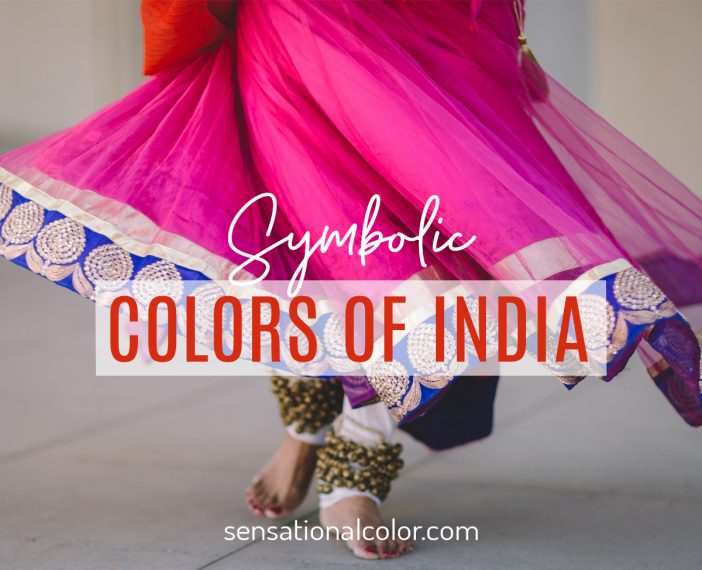
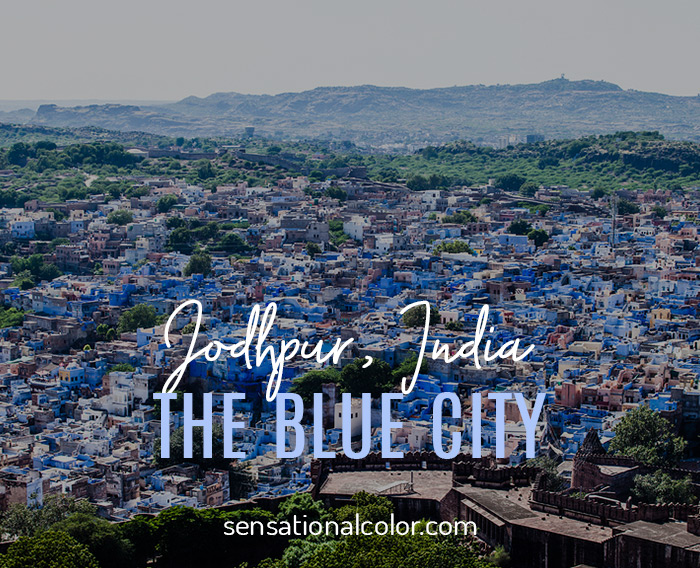
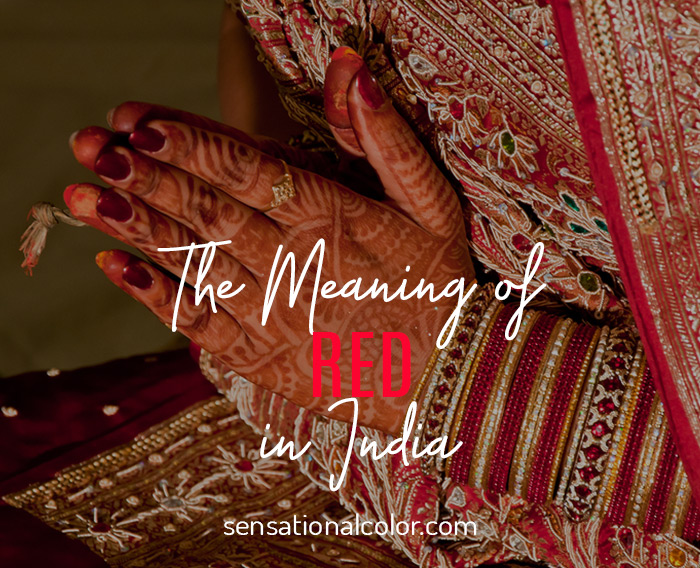

Trying to find out what color turns a man in India on
when was this published?
I originally published the basics in 2007 but I have continued to update even this year. 🙂
thank you
I work for a wonderful couple that are from India. I would like to know what color or colors, that would promote prosperity with their business? I know you said elephants where are a sign of good luck, but I would like to see them Prosper financially.
Thank you for your comment, Denyea. Red is considered an auspicious color in India and related to prosperity as is gold.
ders notu selam
Fascinating! Knew some of it, & want to teach students the different symbolism of colour to show respect for each different culture & religious beliefs. Thank you.
I need a colorful crochet Afghan symbolically indicative of trust and friendship from a person born in India. Bright and comforting. Thank you
Awesome writing. It helped me in my competition. I got 1st place. Thanks a ton
Love the colour palette
Thanks for writing about Symbolic Colors of India Loved it!
Really amazing to know that all of the Symbols and Colours associated with Hinduism has a deep meaning and significance with our daily life. Thanks for this!
Wonderful Colors of Dresses
Wonderful Colors of Dresses
The explosion of colors in Indian life reflects the vibrant nature of Indian society. Festivity and colors make up for the lack of monitory richness of individuals and adds to the strength of soul to bare the burden of life.
‘Krishna’ is associated with ‘dark skin’ color, not black. Krishna’s myth confirms his dark color. The use of ‘blue’ color is a metaphorical representation of dark skin in ‘blue’. Similarly, when Shiva had consumed poison his throat (Neel-kantha) is colored with ‘blue’ color not because he had consumed poisoned which has turned into blue color. It is turned dark the color of the skin because of the effect of the poison. In most places, in the traditional work, color does not reflect the reality but metaphorical representation of the color.
Thank you for sharing that information, Amit. You clearly articulated what I found in my research. I appreciate you adding to the conversation.
we want not brand we want information of india flag
I have two very precious friends in Chennai, India and they are expecting their first baby. I live in Colorado in the United States. I’m crocheting a white baby blanket for them but would like to know if there is a more appropriate color for their first baby. Can you give me some suggestions of a better color or is white appropriate? In my process of picking white, I was thinking it represented purity and innocence. Please help me. Thank you!
I have included what I know above and do not have specific information about colors for infants. You can see the meaning on white. You may want to include one or more colors along with the white. Red could be a good option for a boy or girl.
Hello Kate,
I would like to know if I can use the picture of colorful Tika Powder for an article I am writing about India. I will credit the source http://www.sensationalcolor.com. Would this be ok? This would bring any interested individuals to visit your website to learn more. Appreciate a prompt reply. Thank you. Good write-up btw!!
Hi Melina. Thanks for your interest my article/imagees and your kind compliment. The picture of Tika Powder is not one of my own photos but one I licensed from BigStock. You have two options — 1. use as you mention in your comments with credit to the souce where you found it but this is using it without permission from the owner. 2. you can purchase the rights. I recommend the second because I think you will only need a small size, which costs 1 or 2 credits, which is just a few bucks. Here is the link so you can take a look at the options: http://www.bigstockphoto.com/image-47600716/stock-photo-colorful-tika-powders-on-orcha-market%2C-india ~Kate
Thanks for writing about Symbolic Colors of India Loved it!
{smile}
An amazing and an incredible article written on the indian belives on various colors. Helped me in my speech a lot.
Thank you for your kind compliment, Sanjana. I’m glad my article helped you with your speech
Perfect description for meaning of different colors in India. Very nicely explained. Thanks for the article.
You’re very welcome, Utsav. Thanks for taking time to leave a nice comment. I appreciate it.
when u mix all d colours u get black.now u know why krishna is black. He is in everything.
I hadn’t thought of it in that way. Thanks for sharing your point of view.
Further to above, anything vast, infinite and calm and superior gets blue in colour for example Ocean and a clear sky… similarly the aura or radiation around Sri Krishna is such that sages could see not his skin black colour but the colour of strong aura around him which was blue due to infinity, calmness and omniscient associated with the Lord. So the almighty is painted blue & black both.
Ah now I have a better understanding of why Krishna is sometimes shown as black and sometimes blue. Thanks for adding to the conversation.
When all colors are mixed,they become white. Black is not included as it is the absence of color
I believe it depends on whether you’re talking about colors of light or materials (e.g. pigment) that reflect light. In the first case, you are correct and the various colors of light combine to produce white light. In the latter case, the result is different: mixing many different colors of paint eventually produces various shades of brown. How exactly black paint is produced, I am not sure, but I don’t think you can get it from mixing other colors. Anyway, it’s pretty interesting how differently the seeming immateriality of light behaves in comparison to what is material.
Is there a significant color once should use for a baby blanket?
I’m not aware of any significance given to the color of baby blankets. If you find out that there is please let me know. I would enjoy knowing the color meaning.
Hi Kate,
Thanks for this great post!
Do you happen to know which color each Indian state represents by, if there is any such thing?
No I don’t know but if you discover that information I would be interested to find out. ?
Its quite amazing to know that all of the symbols and colors associated with Hinduism has a deep meaning and significance with our daily life. Adding an interesting article that elaborates on the significance of Saffron in Hinduism.
http://www.ishtadevata.com/blog/significance-saffron-hinduism.html
Thanks for your nice comment and for sharing the article.
Your article is very interesting and helped me in my homework a lot.
So thanks for your article.
I’m happy that I could help you with your homework Srishti. I hope you have an excellent school year.
my favorite is green
but who asked you your fav colour?
As Pohindu said the blue color or dark color of krishna depict a kind of racism but Indian found that wheatish color attractive than any other skin color at the same time there are many more stories about the color Khishna had got.
Thanks for sharing more thoughts on this topic, Ashish
what date was this website made ??
Originally in 2005.
Wonderful Colors of Dresses!!!
Red,Black,and White Colors.
I agree, Terry. I love the hot pink, aqua and yellow dresses, too!
Thank you for your article. I’m doing research about Indian aesthetics in a religious context. Do you know more about the meanings of the color pink? Thanks.
Although not specific to India you can find more information on the color pink here http://www.sensationalcolor.com/meaning-of-pink/
Hi there,
i am very fascinated with Indian colours but i have an odd question… what would the colours on a dark red and brown horse breastplate represent ?
I don’t know the answer to that question, Rose. I’d be interested if you do find out what that symbolizes.
Thank your for your very interesting article. You answered many questions I had regarding the use of the colors we so often see associated with India. The photos I’ve seen are a feast for the eyes. Maybe someday I will get to see them for myself.
You’re welcome, Corkie. I’m glad you enjoyed the article and I hope you do get to see India in person some day. It is an amazing place.
Krishna is Black for the record there never has been a race of blue people in the past or present or future SO whatever Sri Krsna represents so does the color Black.
Its funny how people like to distort the truth to fit their own selfish racist ideals
Thanks for sharing your point of view. My research found that the Sanskrit word in its language of origin is primarily an adjective meaning “black” or “dark” however Krishna is often depicted as blue-skinned in art or drawn representations so there are two color associations.
All of my articles on India were reviewed by an editor native to the country specifically because I wanted to make sure I had not misunderstood or misinterpreted any of the color meanings or symbolism.
Ignorance can be overcome by knowledge. Most of the pictures of Krishna depict a blue-colored Divinity. I always assumed he was a darker skintone when He was incarnate. Statues and pictures are used for spiritual inspiration not realistic skintones. Blue signifies the Vastness of Spirit like the sky. I find it unlikely that devotees would intentional be “selfish racist”. People who admire Krishna are not thinking of race when they think of Krishna. Written description in Sanskrit speak of Him being dark. These people who you call “selfish racist” died many years ago. The artists who started painting Krishna blue were the same race as Krishna. Racism exists, but it is totally irrelevant when it comes to one’s image of God, since God doesn’t have a race.
Your point is well taken.
One of the best things about India is colour! There is no shortage of colour here ?
Amelia
So true Amelia. It is one of the many reasons I love visiting India!